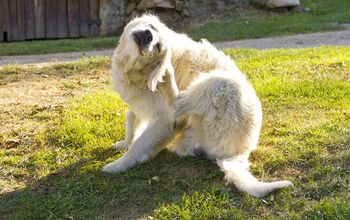My Dog Has A Tooth Fracture – What Should I Do?

Dogs are just as prone to dental problems as humans are. In fact, they may be more prone because they use their mouths not only to eat but to chew on toys as well. There are a number of ways your dog might sustain a tooth fracture and, if he does, it is something you need to take care of promptly. If left without treatment for too long, a simple tooth fracture can lead to much bigger problems.
Causes and Types of Tooth Fracture
Tooth fractures are incredibly common in dogs and they are most likely to occur in the canine and incisor teeth. In most cases, fractures are the result of trauma from chewing on something hard. It is also possible for a dog to fracture a tooth while fighting or playing with another dog, though this cause is less likely. Another possible cause for tooth fracture is trauma to the face resulting from a car accident or some other type of blunt-force injury.
Related: 4 Smile-Worthy Common Doggy Dental Myths
In dogs, tooth fractures may present in varying degrees of severity. In some cases, the fracture may be obvious and diagnosable by sight – the vital pulp of the tooth may even be exposed. In other instances, the pulp may not be visibly exposed but there could be a built-up of calculus (tartar) at the fracture sight. In minor tooth fractures, only the outer enamel is affected. In serious tooth fractures, however, the injury may involve the deeper structures of the tooth such as the nerve itself or the blood supply to the tooth. The symptoms caused by tooth fracture and the recommended treatment options will vary depending on the severity of the fracture.
Common Symptoms
A fractured tooth is very likely to cause your dog varying degrees of pain depending on the severity of the break. Unfortunately, many owners fail to notice fractured teeth in their dogs simply because the dog is unable to communicate the fact that he is experiencing pain. Dogs are wired to hide their pain because it may put them at a disadvantage when faced with a stronger adversary. You may not even know that your dog is in pain unless you observe symptoms like loss of appetite or chewing with one side of the mouth.
In addition to pain, tooth fractures often lead to inflammation or swelling of the gum and the surrounding tissue. Infection is a serious complication that may result from a tooth fracture and, in severe cases, it could result in the death of the tooth. At this point, the tooth will no longer be painful but the infection could continue to spread deeper into the bone supporting the tooth – at this point, the pain could return. As the bone supporting the tooth and the surrounding tissue becomes infected, an abscess may form and this could result in further swelling both inside and outside the mouth. If the abscess is left untreated, it could burst inside the mouth.
Treatment Options
The treatment options for tooth fractures in dogs vary depending on the severity of the fracture. If the damage is mild to moderate, adding a crown may be enough to repair the damage to the tooth. In severe cases, it may be necessary to extract the tooth. After extraction, the area must be sealed with some type of restorative lining to prevent infection. Regardless which treatment option is used, you will need to restrict your dog’s activity and diet for a little while until he recovers.
Tooth fractures are not only common in dogs but they have the potential to become serious. Keep an eye on your dog for signs of pain and, if you suspect a tooth fracture, seek veterinary care immediately before the problem gets worse.

Kate Barrington is the loving owner of two cats (Bagel and Munchkin) and a noisy herd of guinea pigs. Having grown up with golden retrievers, Kate has a great deal of experience with dogs but labels herself a lover of all pets. Having received a Bachelor's degree in English, Kate has combined her love for pets and her passion for writing to create her own freelance writing business, specializing in the pet niche.
More by Kate Barrington























